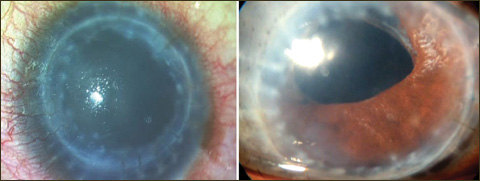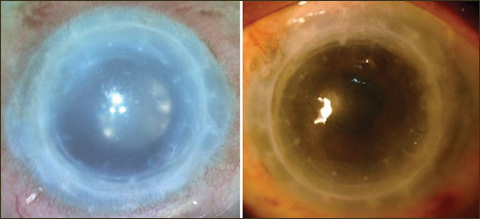Good early results seen with pre-Descemet’s endothelial keratoplasty in failed grafts
PDEK seems to overcome many of the common factors associated with graft failure.
Click Here to Manage Email Alerts
Graft failure in any situation can happen due to inherent defects in the donor graft or pre-existing pathology in the recipient. Inherent graft issues such as low endothelial cell count, surgical trauma to the graft and endothelial disease in the donor can cause early graft failure. Graft rejection is another main etiology that can happen, especially in full-thickness keratoplasty. Lamellar keratoplasty procedures have been shown to have fewer incidences of rejection, but rejection has been noticed after deep lamellar keratoplasty. The corneal stroma is the culprit often recognized as the cause of rejection because of its antigenic nature.
A failed penetrating graft can be replaced by another penetrating full-thickness graft or by an endothelial graft. In this article, we will discuss our experience of pre-Descemet’s endothelial keratoplasty in previous failed grafts.
Graft failure
Graft failure can be primary or secondary in origin. Primary graft failure is defined as failure of the graft to clear after surgery due to endothelial dysfunction and presents with persistent, non-resolving corneal edema and failure to show visual acuity improvement after the first surgery. Endothelial trauma, elderly donors and donor tissue diseases have been hypothesized for the causes of primary failure. Secondary failure refers to failure of the graft after an initial period of clearance or normal function. Graft rejection is one of the common causes of secondary graft failure. Graft infections, ocular surface problems and recurrence of host disease are the other causes.
Even though the incidence of endothelial rejection is less with endothelial keratoplasty, it has still been reported. Penetrating keratoplasty is common with stromal rejection, and this demands for measures to be taken to reduce the incidence of rejection. However, prolonged steroids predispose patients to the risk of ocular hypertension and sometimes steroid-induced glaucoma and secondary cataracts, which in turn threaten best corrected visual acuity.
Reoperation in graft failure
Challenging cases often pose a dilemma for the ophthalmologist over whether to proceed with another surgery in patients who have a failed graft. A failed PK can be corrected by repeat PK or primary endothelial keratoplasty. The advantages of endothelial keratoplasty in failed PK cases are the closed globe procedure; less risk of graft rejection; fewer surgical maneuvers; and absence of complications inherent to PK such as suture infection, glaucoma and astigmatism. However, performing endothelial keratoplasty requires suitable training skills, immense ground knowledge and confidence.

Images: Agarwal A



PDEK in failed PK graft
In failed graft procedures, it is always better to go for young donor grafts with endothelial cell counts higher than 2,800 cells/mm2 and hexagonality greater than 40%. Eyes with a low cell count, from elderly donors or with prolonged storage time should be excluded. Donor graft preparation is the same as for any PDEK procedure (Figure 1), as we have reported previously. A 30-gauge needle attached to a 5-mL syringe was inserted from the limbus into the mid-peripheral stroma. Air was slowly injected into the donor stroma until a type 1 big bubble was formed. The bubble wall was penetrated at the extreme periphery, and trypan blue was injected to stain the graft, which was then cut with a pair of corneoscleral scissors and covered with the tissue culture medium.
Under peribulbar anesthesia, a trocar anterior chamber maintainer (TACM) was placed at the limbus. Descemet’s membrane was scored all around, with a diameter smaller than the PK graft. The graft-host junction should not be disturbed with undue force or manipulation. Descemet’s membrane was then stripped off gently via the main port. The donor PDEK lenticule was inserted into the anterior chamber with a customized injector. It was attached to the recipient bed by careful unrolling with an air bubble and attached to the overlying recipient stroma. Margins were swept in case of tight roll on the endothelial side under air with a reverse Sinskey hook. Intrachamber positive pressure was maintained thereafter for a short time by an air pump connected to the TACM. The main wound was closed with 10-0 monofilament nylon interrupted sutures, and the previous graft-host interface was rechecked for any leak. The patient was laid supine for 30 minutes in the operating room and then shifted.
Results and outcomes
In our experience of PDEK in failed grafts, 13 eyes have been operated: seven with previous primary PK (53.8%), two with Descemet’s stripping endothelial keratoplasty (15.4%) and four with Descemet’s membrane endothelial keratoplasty (30.8%). Seven eyes (53.8%) presented as secondary graft failure (graft rejection being common after PK), and five eyes (38.4%) had no clear graft after surgery. All five eyes with no significant improvement in best corrected visual acuity after primary surgery had elderly donors older than 50 years.
There was significant improvement in BCVA (P = .003) (Figure 2) after PDEK. The mean preoperative and postoperative BCVA in Snellen’s decimal equivalent was 0.02 ± 0.1 and 0.23 ± 0.2, respectively. Preoperative central corneal thickness was 758.3 ± 75.8 µm, and postoperatively it was 594.2 ± 52.6 µm. There was a significant decrease in central corneal thickness in the immediate postoperative period in all eyes (P = .001). There was graft detachment in one eye, and air injection was performed. A postoperative grade 4 anterior chamber reaction was seen in one patient and treated with medical management by steroids. There was no improvement in vision in two of 13 eyes (15.4%). Primary graft failure was seen in two eyes after PK and one eye after DMEK. Two eyes required PK, and one eye required a keratoprosthesis. Recurrence of dystrophy, the primary corneal disease, was seen in one eye. Out of 13 eyes, there were three eyes with donor age younger than 20 years (Figure 3).
Precautions in failed grafts
When operating in an eye with previous Descemet’s stripping automated endothelial keratoplasty, Descemet’s membrane stripping can release the adhesion of the old DSAEK graft, and hence care is taken not to give excess pressure. Loose adhesion and early postoperative secondary PDEK can also predispose this. DSAEK might possibly modify the stromal proteins and thereby impair the adhesion of the PDEK graft as well. Good intraoperative air pressure and proper postoperative positioning will aid in strong adherence (Figure 4). When the size of the PDEK graft is smaller than the DSAEK graft, postoperative migration and endothelial cell morphological changes will usually compensate for corneal recovery.
In eyes with PK, the graft-host junction is usually not interrupted intraoperatively. The size of the PDEK graft is preferred to be smaller than the PK graft because there can be rolled edges or folds in large grafts that may not fit into the curvature of the original stroma. If the primary PK graft gives way intraoperatively, the wound has to be sutured to maintain wound stability. Other postoperative complications such as graft detachment, dislocation and reverse flap can also happen when operating on failed grafts. Donor grafts that are smaller than the host PK and the presence of prior glaucoma drainage devices are risk factors for higher rates of graft dislocation. Non-visualization during surgery has been one of the challenges faced by surgeons when operating on failed grafts; however, PDEK with an endoilluminator helps in visualization of the graft even in cases with corneal edema.
Timing of the secondary surgery has always been a diagnostic dilemma in failed grafts. For DMEK, if the graft does not get attached or clear by 3 months after surgery, one can proceed with secondary PDEK. In long-standing corneal edema, stromal fibrosis and anterior surface irregularities might occur and limit the visual outcome of repeat surgery. This is similar for secondary PDEK, also. Loss of endothelial cells, presence of fibrocellular tissue on the stromal surface, retained Descemet’s membrane on the stromal surface and epithelial ingrowth can be some of the reasons for primary endothelial graft failure. Non-adhesion of the graft is one of the main challenges following DMEK, which can happen due to adhesion difficulties between Descemet’s membrane and stroma of the failed graft. This issue has been optimized by the use of a PDEK graft, which contains the additional pre-Descemet’s layer along with Descemet’s membrane, which aids in adhesion. Ultrathin-DSAEK shares the improved visual outcome and lower immunologic rejection rate of DMEK over DSAEK while minimizing all types of postoperative complications, but PDEK does not require the advance instrumentation required for DSAEK.
Conclusion
Endothelial loss, elderly donors, donor tissue diseases and graft rejection are common reasons for graft failure. PDEK seems to overcome many of these factors in terms of less specular loss, young donors and lower rejection rate. From our preliminary results, we observed that PDEK in failed grafts had satisfactory functional outcomes with respect to visual acuity and quality of life.
- References:
- Agarwal A, et al. Br J Ophthalmol. 2014;doi:10.1136/bjophthalmol-2013-304639.
- Agarwal A, et al. Cornea. 2015;doi:10.1097/ICO.0000000000000486.
- Ang M, et al. Clin Ophthalmol. 2011;doi:10.2147/OPTH.S25973.
- Ćirković A, et al. Cornea. 2015;doi:10.1097/ICO.0000000000000295.
- Clements JL, et al. Cornea. 2011;doi:10.1097/ICO.0b013e3181f7f163.
- Kumar DA, et al. J Cataract Refract Surg. 2015;doi:10.1016/j.jcrs.2015.05.015.
- Kymionis GD, et al. J AAPOS. 2012;doi:10.1016/j.jaapos.2011.09.009.
- Weller JM, et al. Am J Ophthalmol. 2015;doi:10.1016/j.ajo.2015.03.010.
- Yoeruek E, et al. Cornea. 2013;doi:10.1097/ICO.0b013e31828321c1.
- For more information:
- Amar Agarwal, MS, FRCS, FRCOphth, is director of Dr. Agarwal’s Eye Hospital and Eye Research Centre. Agarwal is the author of several books published by SLACK Incorporated, publisher of Ocular Surgery News, including Phaco Nightmares: Conquering Cataract Catastrophes, Bimanual Phaco: Mastering the Phakonit/MICS Technique, Dry Eye: A Practical Guide to Ocular Surface Disorders and Stem Cell Surgery and Presbyopia: A Surgical Textbook. He can be reached at 19 Cathedral Road, Chennai 600 086, India; email: dragarwal@vsnl.com; website: www.dragarwal.com.
Disclosure: No products or companies that would require financial disclosure are mentioned in this article.
